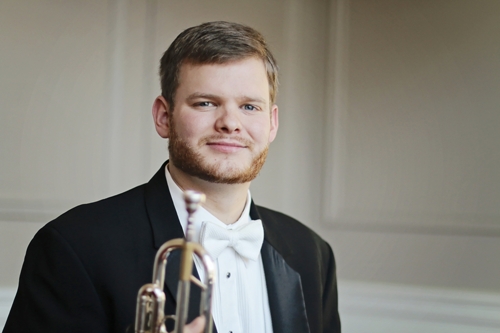As Beethoven’s hearing retreated, he retreated from society as well, unable to bear the thought of an incurable condition or asking people to speak louder.
One of the world’s most well-known composers, he even contemplated suicide around 1802. Music was his saving grace, inspiring him to persist because: “It seemed to me impossible to leave the world until I had produced all that I felt was within me,” according to program notes for Holland Symphony Orchestra’s Classics II: Beethoven’s World.
His mental state and desire to create new compositional styles set the tone for works like his Symphony No. 3 in E-flat Major, Op. 55, nicknamed “Eroica,” which closes out the Oct. 28 program.
“It is a pivotal work,” said Music Director Johannes Müller-Stosch. “Beethoven found his own unique voice in Symphony No. 3. It’s very different than No. 1 and 2.”
Overall, the program is more classical, and Symphony No. 3 balances well with Beethoven’s Coriolan Overture, Op. 62 and Hummel’s Trumpet Concerto in E-Flat Major.
Beethoven composed Coriolan Overture, which opens the program, for his friend and Viennese poet and playwright Heinrich Joseph von Collin’s tragic work in 1807. Characterized as a “restless, anguished work — terse and austere,” the piece dissolves into silence.
HSO then welcomes Holton native, Grand Valley State University graduate and Detroit Symphony Orchestra principal trumpet Hunter Eberly to perform Hummel’s Trumpet Concerto. The HSO hasn’t programmed a trumpet concerto in a while, and Beethoven and the Hummel go very well together, Müller-Stosch said.
“We’ve heard nothing but rave reviews about Hunter’s playing in the Detroit Symphony,” Müller-Stosch said. “We also like to use artists who are from Michigan and have a connection to Holland. It creates kind of a buzz and that’s certainly the case with Hunter.”
Hummel’s Trumpet Concerto is one of the top three trumpet concertos in the repertoire, a very classic piece with three clearly defined movements, Müller-Stosch said.
Eberly also played his first professional gig with the HSO while at Grand Valley, and looks forward to returning to West Michigan to play for a crowd that includes friends and family.
He hasn’t performed the concerto as a soloist before, but said it’s a fun piece that takes the audience on a nice little ride.
“It’s one of the first pieces written for a modern chromatic trumpet,” Eberly said. “It’s kind of a staple in the repertoire. There’s some nice fanfares in the first movement — the second movement is really lyrical, very beautiful.”
The concert concludes with “Eroica,” which is among Beethoven’s most celebrated works. Described as more sublime than beautiful by early listeners and critics, “Eroica” was markedly different due to its length, technical challenges and innovations.
The symphony signifies a turning point in Beethoven’s career and the history of music.
“It’s one of the longest symphonies and it definitely pushed the envelope,” Müller-Stosch said. “The critics didn’t like it necessarily because they were expecting symphonies similar to No. 1 and 2.”
The first movement, featuring a cello melody, is followed by a funeral march in the second movement. Beethoven also plays with metric ambiguities and features the French horns in the middle trio section, then casts the finale as an unusual set of variations. Müller-Stosch said the use of three horns instead of two horns is what really sets it apart.
“When you have three horns, you can establish harmony just by the horn section,” he said. “That’s an expressive tool, because you can introduce new harmonies just from the brass section.”
Classics II: Beethoven’s World
Holland Symphony Orchestra
Jack H. Miller Center for Musical Arts at Hope College
221 Columbia Ave., Holland
Oct. 28, 7:30 p.m., $5-$20
hollandsymphony.org, (616) 796-6780





